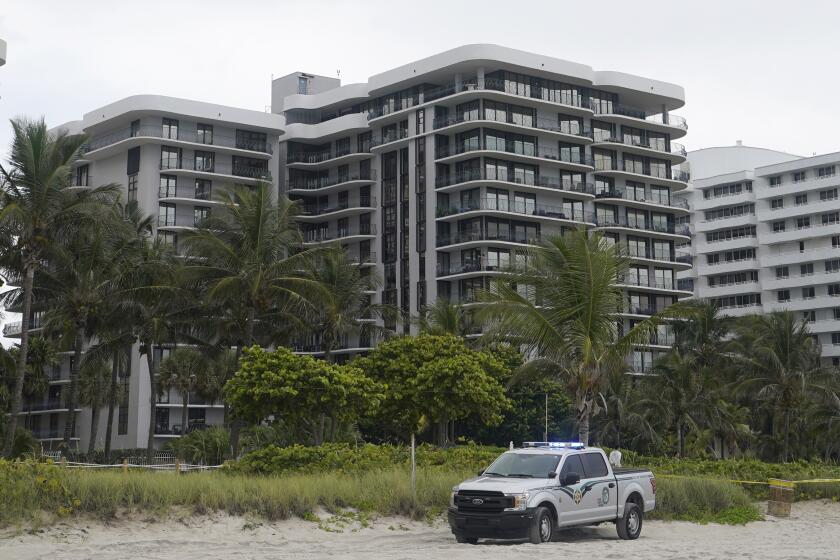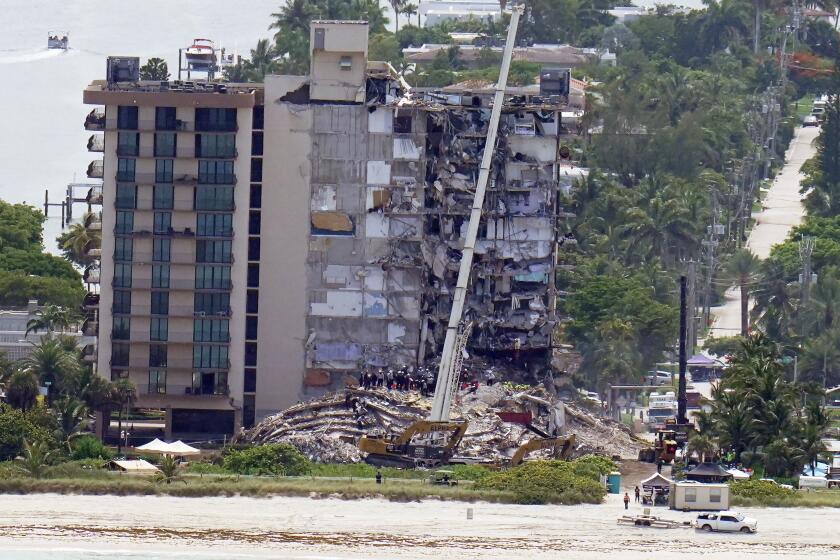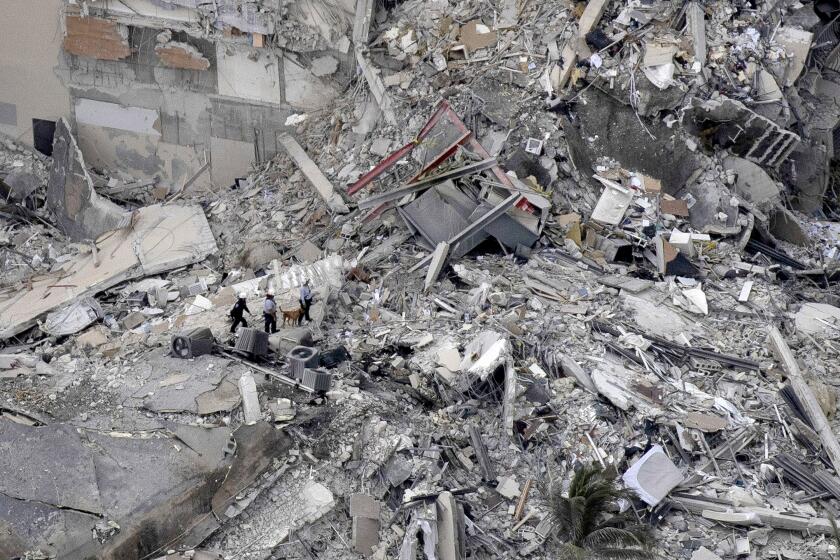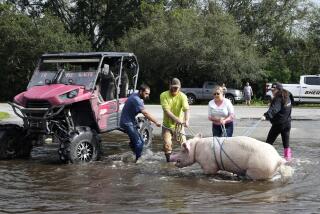After the fall of a Florida condo, some residents confront their future on the coast
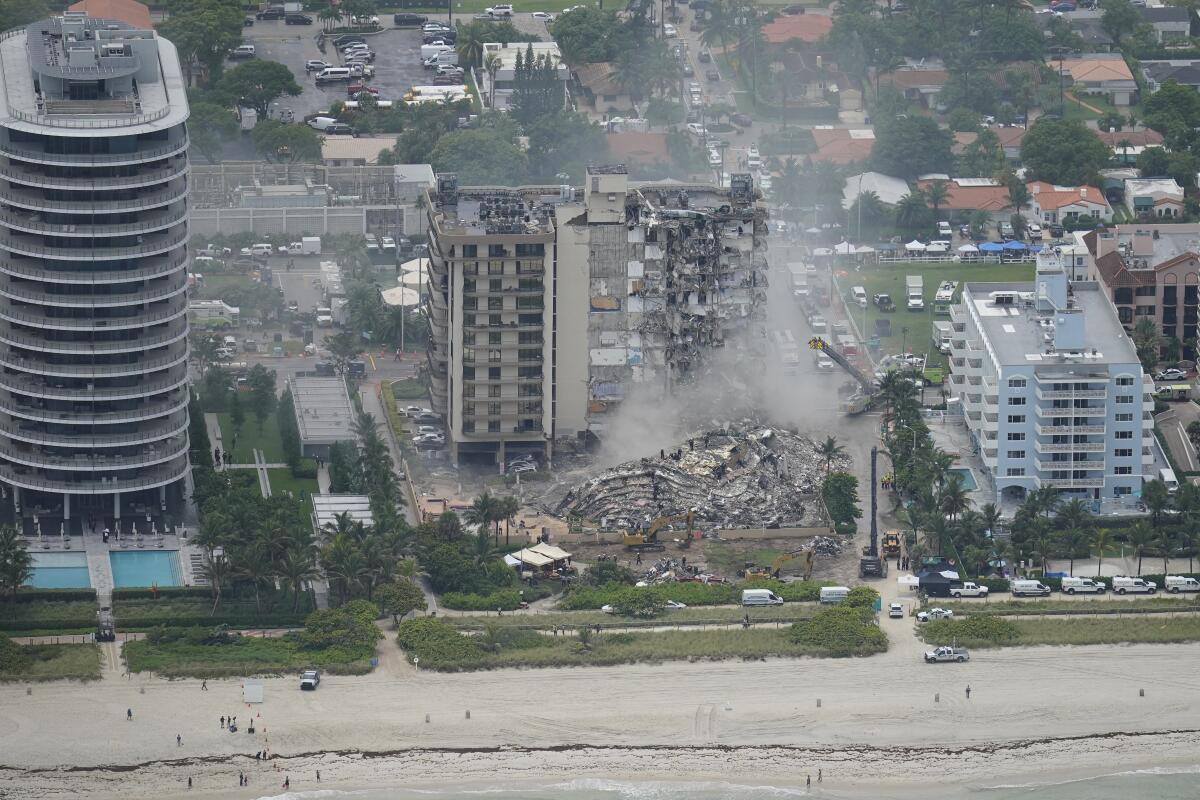
- Share via
SURFSIDE, Fla. — Sitting on his 9th floor balcony, watching palm trees sway in front of the turquoise blue of the Atlantic Ocean, Christian Ginman could no longer just enjoy the view.
He kept thinking about the collapse of the Champlain Towers South less than a week ago, and how the building fell without warning in the middle of the night, 13 floors pancaking into a mountain of debris. He owns a weekend apartment five blocks away.
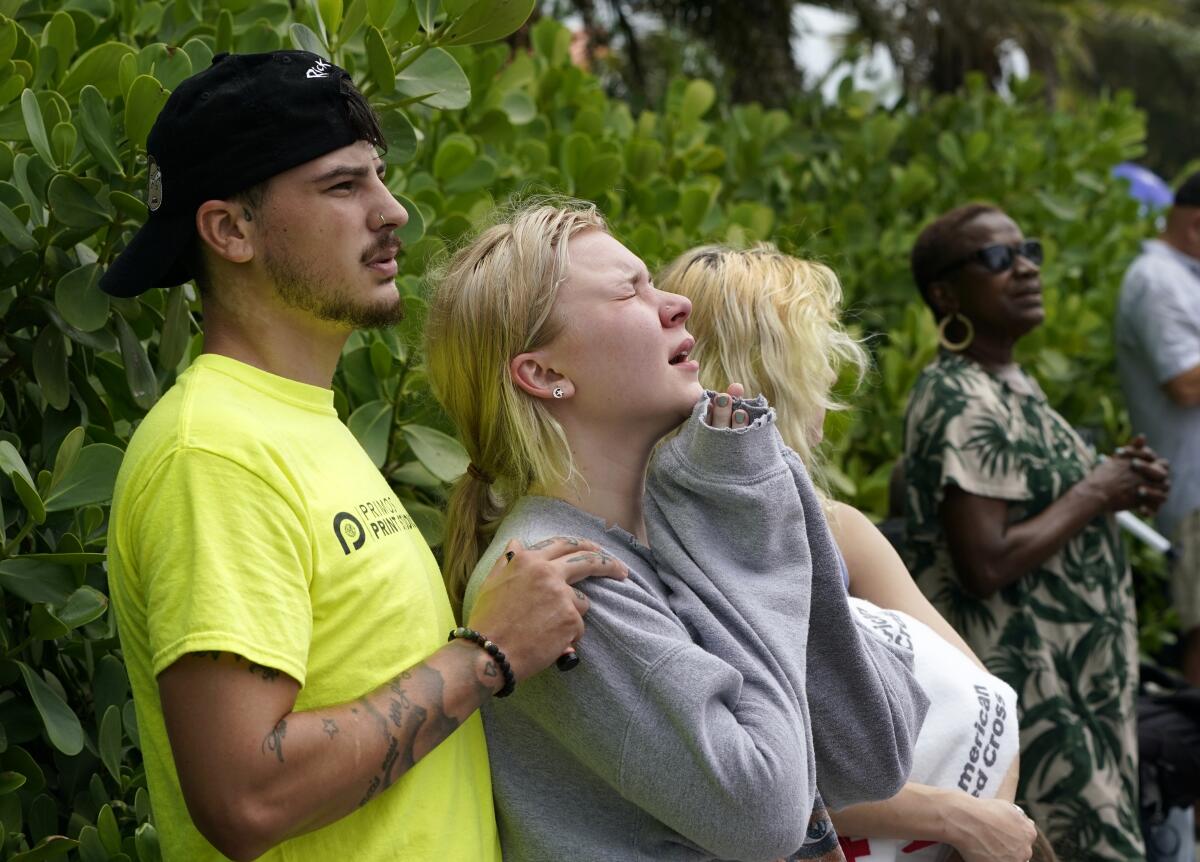
“What building is going to be next?” wondered Ginman, a 49-year-old commercial real estate agent.
As search and rescue teams scoured the rubble in hopes of finding someone alive, authorities said Tuesday that 12 people were confirmed dead and 149 remained unaccounted for in what could be the deadliest accidental building collapse in U.S. history.
Many residents and second-home owners in the tiny coastal city of Surfside, just a few miles northeast of Miami, spoke of being unnerved about their future on this barrier island.
The people inside Champlain Towers South reflected the Miami area’s mix of South American immigrants and tourists, Orthodox Jews and sun-chasing retirees.
The cause of the Champlain’s sudden and spectacular fall Thursday remained undetermined. Some engineering experts say the collapse may have been due to a rare confluence of structural deficiencies and lack of maintenance in a coastal area where buildings are particularly vulnerable to corrosion from saltwater and salt air.
For many who live in Surfside, the disaster has fueled anxiety about the challenges of maintaining local residential buildings. A string of mid-rise and high-rise condos — some decades old, others brand new — loom over the Atlantic shoreline sitting on a plateau of limestone, a porous rock that allows rising seawater to seep up from below.
Many are feared dead and trapped in the rubble after the collapse of part of a 12-story beachfront condo tower in the Miami suburb of Surfside.
In the coming decades, scientists say, buildings across coastal metropolitan Miami and the entire U.S. will be subjected to deepening challenges as sea levels rise and structures become increasingly exposed to saltwater.
“There’s all kinds of additional risks that we’re heading into,” said Harold R. Wanless, the director of the University of Miami’s geological sciences department and an expert on sea level rise.
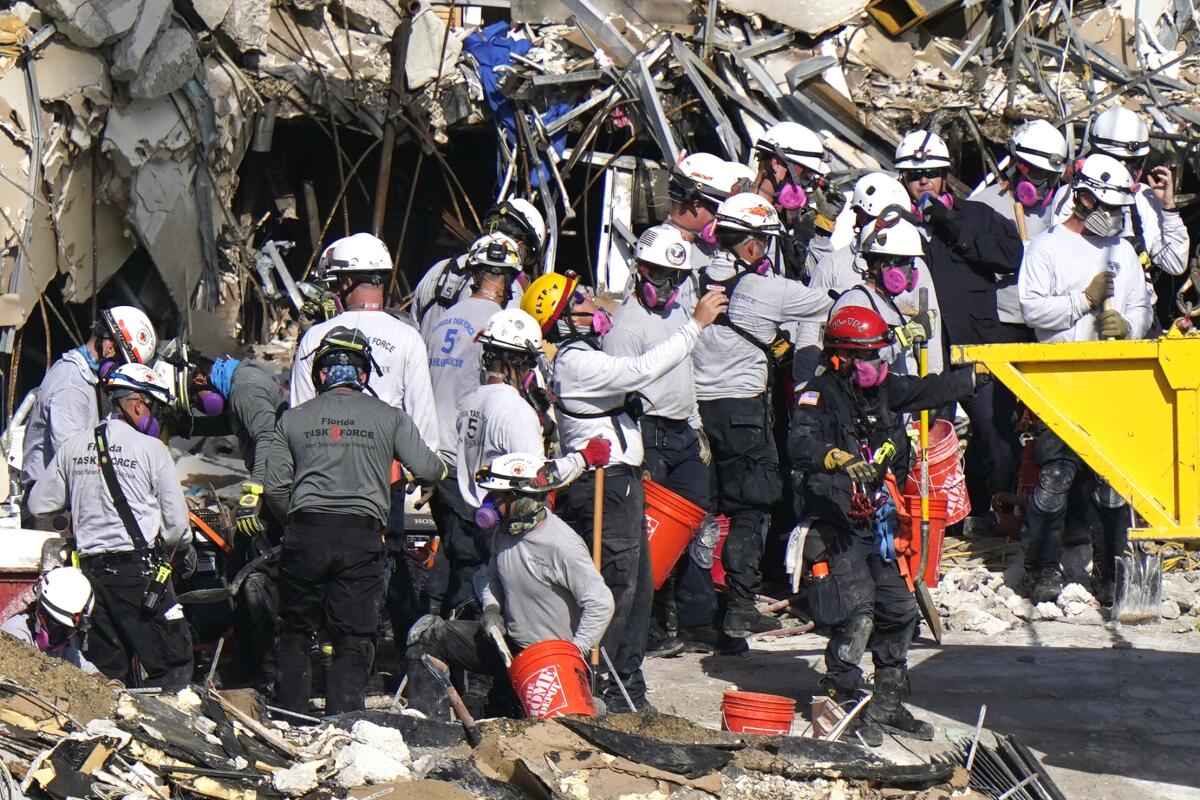
The sea has risen about 6 inches in the Miami area since the 1980s and is probably not responsible for the collapse of the Champlain tower, although further investigation is needed, Wanless said. But a rapidly accelerating ice melt in Greenland and Antarctica could submerge parts of Miami and other coastal areas with an additional 2 to 3 feet of sea level rise in the next 30 years.
Although it is possible to design buildings that hold up in seawater, Wanless said, it’s more costly.
“If you want to look to the future on a barrier island like Miami Beach, with a 2- or 3-foot sea level rise, you’re going to have hundreds of feet of coastal erosion,” he said. “These buildings that are sitting behind the beach right now are going to be sitting out in the ocean, and there’s not much we’re going to be able to do about it.”
Some residents in the twin tower of the collapsed Florida condo building are too afraid to stay, but others say the sister structure is in good shape.
Up and down Surfside, residents who live in oceanfront apartments are asking themselves whether they are safe. Some cannot sleep or are taking stairs instead of the elevator. Others are questioning whether they should renew their leases. Many are looking anew at their surroundings, questioning pools of water in their parking garages or slight cracks in concrete, and wondering about the fragility of life.
“It’s nerve-racking,” said Michael Leitman, 47, an entrepreneur who lives on the second floor of a 12-story condo tower about eight blocks north of the Champlain. “There’s just so much salt in the air, and we’re surrounded by so much water. There’s always something structurally that needs to be focused on.”
Compounding the problem, Leitman said, was that Surfside had welcomed a string of deluxe oceanfront condominiums in the last decade, such as the Fendi Chateau and the Arte Surfside, where Ivanka Trump and Jared Kushner are renting an apartment. An Arte penthouse recently sold for $33 million.
“Look what we did: We built a whole wall of towers,” he said as he stood on the beach promenade, lined with sea olive trees, and pointed up to a row of lavish, mid-rise structures of shimmering glass and metal. “Mother Nature is showing us that we are putting way too much pressure on this area.”
Sara David, a 59-year-old day-care manager who lives in New York but has rented an apartment in Surfside during the last year, said she was so anxious about the collapse that she had trouble sleeping. She was more worried about terrorism than the environment, but she just wanted to know she was safe living on the beach.
“Before I was thinking, ‘Oh, that’s beautiful!’” she said. “Now I’m thinking, ‘I’m taking a chance.’”
Although it could be months before investigators have a complete picture of what went wrong at the collapsed building, there have been signs of structural problems and poor maintenance. The 40-year-old building had not completed its required 40-year recertification and was having work done on its roof and about to undergo repairs for rusted steel and damaged concrete.
Owners of units in the collapsed Florida condo tower were days away from starting to pay for more than $9 million in repairs recommended in 2018.
A 2018 inspection report on the Champlain tower described “abundant cracking and spalling” of concrete columns in the parking garage and warned that a design flaw “and failed waterproofing” on the pool deck could cause “exponential damage.”
Less than three months before the tower collapsed, the president of the condominium association’s board of directors warned in a letter to residents that the damage had “gotten significantly worse” since the 2018 inspection.
David Peraza, a structural engineer at Exponent, an engineering and scientific consulting firm who specializes in the investigation of structural failures, said the problems documented did not explain how a building that had been standing for about 40 years had collapsed.
“It’s still a mystery,” he said. “There’s no smoking gun.”

Although some areas needed repairs, Peraza said, they were not the type of problems or in a location that he would have expected to have caused such a dramatic failure. Investigators, he said, would need to evaluate the original structural design of the columns, the design and insulation of the piles, and the soil conditions.
A study released last year found that the land around the building had subsided in the 1990s at the rate of a couple of millimeters a year. Peraza said that was not necessarily significant: Even if the land was slowly settling, the tower was supported by deep underground piles that should have provided stability.
John Pistorino, a structural engineer who wrote the 40-year building recertification process for Miami-Dade County and has been hired by an attorney to investigate what led to the tragedy, said such a collapse was highly unusual in the United States. Buildings on the coast, he said, were generally built with deep foundations that were designed to be under saltwater.
“It’s natural people are going to say, ‘Am I next?’” he said. “But if buildings are maintained, there’s no problem. We have buildings in Miami that are 100 years old.”
Pistorino dismissed rising sea levels as a problem for structures that had pilings deeper than 100 feet. “If the water comes up 2 feet, it’s not going to affect those buildings at all,” he said.
In the weeks and months ahead, even grimmer moments will follow. And answers about the Surfside tower collapse could take years, if they come at all.
More than 85,000 Miami-Dade County residents live 3 feet below sea level.
For years, the area has been afflicted by “king tides,” a higher-than-normal tide caused by specific alignments of the sun and moon. Even on sunny days, Miami residents have become used to saltwater seeping up onto roads and sidewalks, pooling in car garages, clogging storm drains and killing lawns and trees.
The U.S. Army Corps of Engineers has proposed building a 20-foot sea wall across Biscayne Bay to hold off the rising sea, but even a wall will not protect homes and streets from water rising up through porous limestone
Zhong-Ren Peng, professor and director of University of Florida’s International Center for Adaptation Planning and Design, said that it was too early to know the exact cause of the collapse, but saltwater intrusion could corrode concrete and rebar and cause catastrophic failure of a building’s support.
Whether or not this was a key problem in Surfside, he said, it is a growing problem for coastal areas.
“This is the wake-up call that coastal areas should have higher building standards,” he said.
The Champlain was constructed before Hurricane Andrew, a Category 5 hurricane, slammed into south Florida in 1992, prompting the state to develop more stringent building codes that require new structures to be stronger and better able to withstand hurricane-force winds. But even Florida’s most up-to-date building codes, Peng said, were not sufficient.
“The main issue with Florida’s new building code is that it didn’t consider sea level rise and its impacts,” he said. “The conversation we need to have is whether we should allow new development in those vulnerable areas that we know will be inundated in the next 30 to 40 years. If we do, what higher standard we should adopt to ensure the safety of residents?”
For Joe Cox, 67, a retired merchant marine who has lived for more than two decades in a two-story building in nearby Bal Harbour, about a mile north of the Champlain tower, the fall of the Champlain confirmed a long-term belief: He would never live in a high-rise.
“I don’t think there are supposed to be high-rises here,” he said as he walked along the promenade one evening before dusk. “Coastal Florida was not meant to be developed. As far as I’m concerned, it’s greed. It’s the nature of America.”
More to Read
Sign up for Essential California
The most important California stories and recommendations in your inbox every morning.
You may occasionally receive promotional content from the Los Angeles Times.


